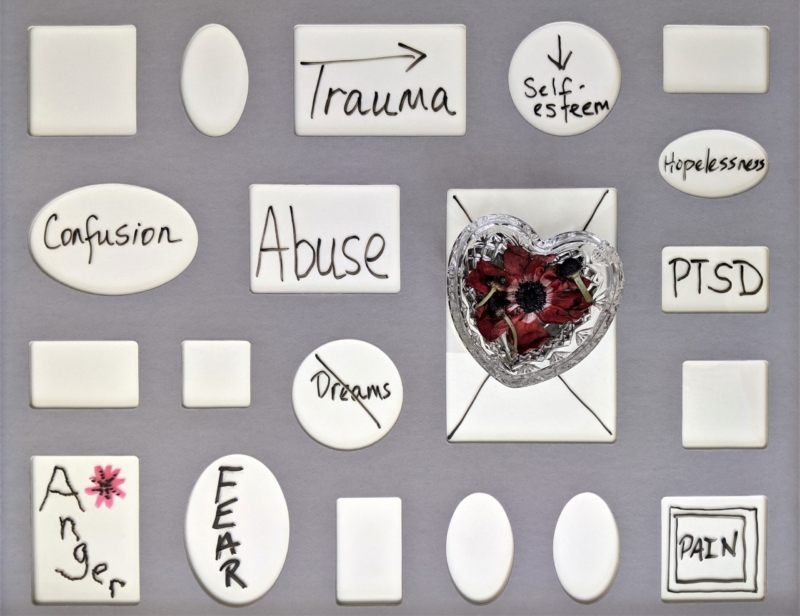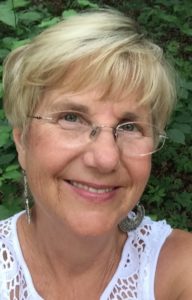Transforming the Inner Critic
Brainspotting and Inner Family Dialogue
Written by Marie and Benita A. Esposito, MA, LPC, LCMHC
Do you have an Inner Critic who is like a sports reporter that plays a running commentary on how well you are doing? If so, you are not alone. Many of us high-achievers suffer from critical jabs and barbs. The Inner Critic pushes us to succeed, but when we’re not perfect, our Inner Child takes a big hit.
In this story, you’ll meet Marie. She is a bright, kind, creative woman who doesn’t deserve to be plagued by a harsh taskmaster. You’ll see how she and the Holy Spirit tamed her Inner Critic and turned self-loathing into self-compassion. Come along with us on Marie’s journey to her Authentic Self.
Maria’s Background (in her words)
I originally began seeing Benita Esposito in the summer of 2021 when I was 31 years old. I wanted to heal childhood wounds, create an earned secure attachment style, and tap into my Authentic Self.
My perfectionism, self-loathing, depression, and anxiety were at an all-time high. My Inner Critic scolded me saying, “You should be able to handle difficult situations by yourself. You should be self-sufficient. Grow up and stop whining.”
I felt lonely and insecure inside. When the following thoughts came for me, I spiraled into defeat and depression: “What’s the point? Why should I even be here?”
I knew that much of my emotional pain stemmed from the toxic relationship I had with my biological father during my childhood. His emotional abuse and emotional unavailability made me feel unsafe, and that I wasn’t worth his time or energy. I felt like I had to fend for myself when I visited him on weekends. If I was afraid or hurt, I had to be the one to take care of myself. I learned that my needs would be met with anger and frustration.
I always yearned for belonging.
I had no idea how much of my identity was wrapped around my dad’s behavior towards me until I began attending sessions with Benita.

Now, as an educator and student affairs practitioner, I love creating a sense of belonging for students. I want them to feel seen and heard, especially in my writing consultations with them. I’ve turned my emotional pain into my passion to help students feel cherished so they can become their best selves.
One pivotal session showed me a new lens through which to view myself.
At the outset of our session, I mentioned to Benita that I was still learning to be okay with opening up and sharing how I really felt. I told her that I needed her to help me with tapping more into my Authentic Self in our sessions. I admitted to her that I was learning how to bring down my walls, but I was anxious.
My Mask
It was challenging to be authentic because I regularly displayed a veneer that created distance within myself and with others. I realized that I would not be able to get my core needs met if I continued to operate with my mask.
I requested that Benita ask more probing questions to help me fully show up, such as “How are you REALLY doing?” I agreed that I would practice responding with how I REALLY felt … not just waiting for Benita to ask me … and not just saying that I felt fine with a camouflage smile.
My Fears
I admitted that I was afraid of feeling anxious if I showed up as my Authentic Self.
When I imagined someone asking me, “How are you?” and I said, “I’m tired,” I would feel like I was burdening them rather than sticking to the usual “I’m OK.”
I was so afraid that by sharing how I really felt that I would make the other person do more of the “work” in the conversation.
Reflecting upon my insecurities, my Inner Critic told me, “You’re egotistical if you share too much of yourself. Don’t be self-centered.”
Another part of me was afraid of too much exposure if I shared my Authentic Self. I would feel too vulnerable like, the spotlight was on me.
I didn’t like coming across as weak. If I were weak, then I imagined I wouldn’t be accepted. My father rejected me when I was hurt. I imagined other people would reject me, too. If I was too much, too real, or too vulnerable, I wouldn’t be accepted.
If I wasn’t accepted by others,
I berated myself.
Self-loathing skyrocketed.
 Here’s how Brainspotting helped Marie heal. Written by Benita Esposito
Here’s how Brainspotting helped Marie heal. Written by Benita Esposito
I used a method called Brainspotting to help Marie heal the emotional pain that resulted in depression, anxiety and feeling like she didn’t belong. Let me explain a little about how Brainspotting works. It’s not like talk therapy.
Dr. David Grand, the originator of Brainspotting, discovered that where we look affects how we feel emotionally and physically.
When we look in a certain direction, emotional wounds can be activated so we can heal them. If we focus in another location, calmness or creativity can be stimulated. The Brainspotting practitioner helps the client determine these visual spots. Brainspotting also helps us tap into the healing power of our spiritual connection.
Much of the processing takes place on a physical and emotional level beyond our awareness.
Our prefrontal cortex (the conscious part of us) can’t perceive the healing or explain it.
That’s why some clients call Brainspotting a mystery.
Here’s a brief description of Marie’s process.
I helped Marie choose two spots that were relevant to her issue.
1. She found a visual RESOURCE spot that helped her feel calm, grounded and safe. I used a teacher’s pointer to mark this spot for her to focus on. This correlated with where she felt most calm and grounded in her body.
2. She located a visual ACTIVATION spot which provoked her anxiety and self-loathing. Again, I used a teacher’s pointer to mark this spot for her to focus on. This correlated with where she felt most activated in her body.
Marie wore stereo earphones to listen to calming biolateral music engineered by Dr. Grand. The music moves between the ears, stimulating both sides of the brain. This accelerates the healing process.
Marie stared at her chosen spots and allowed thoughts and feelings to surface spontaneously. She watched the thoughts and feelings come and go without judgment … moment after moment.
I told Marie that she could share what she experienced or remain silent. Either way works fine.
Brainspotting accesses the amygdala
where emotions and memories are stored.
The procedure is so effective because it
processes difficult unconscious material
in a way that doesn’t overwhelm us.
The Brainspotting practitioner helps
the client remain in their window of tolerance.
We combined Internal Family Dialogue with Brainspotting.
We all have parts inside our inner family. For example, we have an Inner Critic, an analytical Adult, a spontaneous fun-loving Free Child, a people-pleaser Adapted Child, a Rebellious Child, and a Nurturing Parent.
Sometimes one part, such as the Inner Critic, dominates the other parts like an abusive husband would belittle his wife. This was at the heart of Marie’s self-loathing.
To heal emotional wounds and coping patterns, we bring love and understanding to each part from the Authentic Self, which is also called the Wise Self or the Spirit-led Self.
We help the inner family communicate with each other and build healthy relationships.
Often, we start with the Inner Critic because its voice is so loud. We acknowledge the critic for the role it has played. The critic unconsciously tries to protect other parts. These are often exiled scared parts who are too afraid to show up.
We want to help the wounded exiled parts come out so we can help them heal.
Other inner family members might be afraid to let the exiles emerge for fear that they will overwhelm the family with their pain. Clients sometimes say, “If I let myself cry, I might cry forever or I might not ever come out of it.”
We ask the exiled parts not to overwhelm the family. Most of the time, they will agree. We help them come out a little at a time so the whole family can adjust.
As we help the hurt exiled parts heal, the critic no longer has to work overtime to protect that part. It can relax and step back. It no longer needs to dominate other parts with its heavy-handed orders.
Over time, the parts learn how to build bridges where there were walls before. Marie was learning how to create a healthy inner family where all parts were working together to meet everyone’s needs while receiving guidance from her spirit-led Self and the Holy Spirit.
The BRAINSPOTTING PROCESS
The Set-Up
· Marie put on her headphones and listened to David Grand’s biolateral music.
· She identified the issue as self-loathing when people don’t accept her.
· She located this issue in her body. It was below her heart. It was tight and felt like pressure. We call this the body activation spot. The color was red.
· Marie rated the intensity of the activation of her issue. It was level 8 where 10 is high.
· She located the most calm and grounded part of her body: her tummy. We call this the body resource spot.
The scene in Marie’s words: My seven-year-old Inner Child is wrestling with my Inner Critic as they always do.
I notice the thoughts, “You’ll never get it right. You’ll always be alone.”
The wounded Inner Child is losing the match.
Benita: Do you hear a voice sending you those critical messages? Whose voice is it?
Marie: My biological dad fed me those critical messages. He’s trying to silence me. My walls formed when I was seven.
Benita: You introjected messages from your father. You swam in the only fish bowl you had.
Marie: I want to break this vicious cycle.
Marie addressed her father as if he were in the session. “Dad, these messages are not beneficial to me. They never were. I give them back to you. You are their owner.”
I see a giant stack of papers. I’m giving them back to him. I have a sense of relief and release. My shoulders are looser.
There is still emotional pain in my heart center. The wound is still there from all that pollution and garbage.
Marie tunes into another part. “This is the purest part of me … the one who is most symbolic of who I am … before any bad influences occurred. It’s like a breeze … you can feel it but you can’t see it. It’s my spirit. It’s strong and resilient and wise. It zig-zags, pulling me with it. Now there’s nothingness … a peaceful nothingness.”
My pain is level 7. It’s in my stomach.
My Nurturing Parent touches the places inside of me that are wounded to heal them. There’s red light around them. It hurts.
Now, there’s less tension. “This is for your good,” she says. “You’ll feel better in time. It’s gonna be OK.”
Marie looked at the resource pointer with one eye which increased the intensity of the processing.
Marie: I feel calm. I am hopeful about moving towards self-acceptance. I feel calm in my core and in my gut.
Benita’s commentary: Marie was developing more body awareness so she could stay grounded and present.
The following internal conversation developed spontaneously.
· Holy Spirit: You’ll be OK. You will get there. You will overcome.
· Marie breathed a long exhale.
· Benita’s commentary: The parasympathetic nervous system coming online to soothe the body.
· A Bible verse comes to mind: I can do all things through Christ who strengthens me.
· Sigh (parasympathetic nervous system coming online)
· Benita’s commentary: The parasympathetic nervous system coming online to soothe the body.
· I feel a peaceful nothingness … no negative thought spirals. It feels great.
· Sigh.
· Benita’s commentary: The parasympathetic nervous system coming online to soothe the body.
· Level 4
· Looking at the Resource pointer: You are loved.
· Looking at the Activation pointer: You are nothing, worthless.
· Looking at the Resource pointer: It’s OK to be OK inside yourself. I’m still OK even if Dad doesn’t think so.
Marie talked to her father as if he were here.
“Dad, even if you don’t think I am OK, I know I am. It’s OK to be me. I don’t need you to tell me who I am. I don’t need you to silence me. Don’t silence me anymore! You’ve really hurt me over the years. You’ve caused me to second guess myself. Now, I’m choosing to put my thoughts and feelings first. You may not have a stronghold on me anymore.”
Benita to Marie: Repeat this statement three times so it soaks into your mind and body: “I’m choosing to put my thoughts and feelings first. You may not have a stronghold on me anymore.”
Marie repeats the sentences three times, each time with more feeling and louder.
Marie: My body feels like a weight has been lifted. I feel lighter and stronger from within. I know who I am.
Marie spoke to her father again in her mind:
“You don’t know who I am. I have come a long way and I am moving forward. I don’t need you and your lies to get in the way.”
Marie: That felt really good. My body feels less heavy. I’m feeling strong and resilient in the innermost core of my being.
Now, I’m not being thrown by all these punches … no more wrestling with my Inner Critic. I feel bigger and stronger than those thoughts now.
I heard the Holy Spirit say, “Good job, Marie! You did well. Keep relying on me and depending on me so you can see clearly who you are because I’m working through you. You are not who your father said you were.”
Marie repeated three times: “I am not who my father said I am.”
Marie: My body feels so much strength in my core. It’s like an uprising … waves are coming up. I’m ready to take on whatever challenge is ahead of me.
The ending level was a 2 after 30 minutes.
Marie reported, “My chest is lighter and peaceful. The color is white.”
DEBRIEF
Marie: This was a core transformation. I feel a lightness of Self and my Being is strong. I’ve never felt this way before. I have a new kind of discernment. I no longer feel inclined to embrace what is not authentically me.
I’m looking forward to doing more work like this and helping the Inner Critic. He’s taking a nap now … his first nap ever! He doesn’t have to work so hard now that he knows naps are possible. LOL
Benita to Marie: We addressed the CORE IDENTITY that you formed at age seven (or maybe younger). You made a new core decision about your identity. Your primary attachment is now with the Holy Spirit, which replaces the primary attachment with your dad who peppered you with all the critical demeaning messages. Good job, Marie!
MARIE’S COMMENTS
Benita guided me through core identity work. It was such an incredible experience. During our session, I remember thinking that I wish I could feel this weightless blissful nothingness all the time.
I recall after my session looking above me and noticing that I no longer felt the heaviness that used to suffocate my self-esteem and weigh me down. I had a clear mind without being bombarded with self-loathing and negative feedback loops. I felt free, light, and strong all at the same time.
The next day I woke up to a feeling of hope and security, like the sanctuary I had been searching for had been found inside of me.
Brainspotting helps build community inside of my Self. The whispers that flow between each of the family members become more audible to my conscious mind. This internal communication creates the ideal conditions for self-discovery, transformation, and healing.
I know that because of my work with Benita that my life has been transformed, and that I am able to appreciate who I am. I believe the events that took place in my session with Benita gave me the opportunity to redefine myself, and I’ve been reawakened to my true identity.
Benita is an amazing guide. Her discernment and uncanny ability to tune into the spiritual realm is the impetus for miracles. Benita’s gentle yet strong presence, coupled with her intentionality, created the ultimate safe space for me to bring my walls down and discover the deep healing that I sorely needed.
 CONTACT INFORMATION
CONTACT INFORMATION
Benita A. Esposito is a licensed psychotherapist in Georgia and North Carolina with four decades experience.
If you would like to schedule a complimentary 10-minute Discovery Call for counseling or to inquire about an intensive retreat, please complete the Contact Form.
Benita offers “distance counseling” via Zoom videoconference to residents of Georgia and North Carolina. If you live in another state, you may receive spiritual counseling and life coaching.
Please comment on this article or leave a question. Please share this article with your friends on social media.
Photo credits: Little girl by Benita Esposito. Eye by Drew Dizzy Graham on Unsplash. Trauma collage by Susan Wilkinson on Unsplash.





